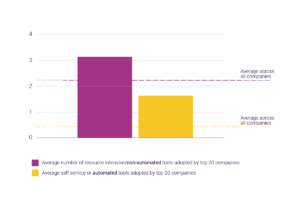4 Ways to Improve Customer Service by Combining Omnichannel and AI
Availability and automation are essential for today’s customer service. Stay competitive with concrete tips for Omnichannel and AI chatbots.
schedule7 minute read
Customer service is the core of a brand’s customer experience. While marketing, product development and sales all play a part ensuring effortless buying experiences, customer service and support is central to customer’s overall experience through pre-purchase, purchase and post-purchase.
According to a Bain & Co. report on “Closing the Delivery Gap”, 80% of companies believe that they provide adequate service. But only 8% of customers believe their needs are met by these companies.
Here to skim? Skip straight to the sections that interest you most:
- Channels: Be Where Your Customers Are
- Availability: Answer When Your Customers Need You
- Helpfulness: Keep Your Answers Relevant and Helpful
- Proactivity: Use Saved Time to Improve Customer Experience
- Summary
It’s no surprise when we see how slowly many brands have adapted to remain competitive in their customers’ eyes. For example, a survey by the Institute of Customer Service reports that 62% of customer complaints are about bad interactions rather than product quality.
There is hope. New technology brings new opportunities to improve customer service and customer experience. The hybrid approach to customer service, where a balance of automation and people is encouraged, was emphasised in McKinsey’s B2B customer experience report.
And as GetJenny (a LeadDesk company) highlights in their Customer Experience Trends Report 2021, high performing Nasdaq-listed companies in the report invest more in automation and AI technologies to augment their customer service.

Data Source: GetJenny Customer Experience Trends Report 2021
With new technologies, we can improve our customer service, reduce churn and increase CLV, earning happier customers and more productive customer service teams.
Save time and serve customers better by investing in these areas:
1. Channels: Be Where Your Customers Are
Spoiler: it’s probably not going to be MySpace. But it does depend heavily on your customer and your offering.
For many brands, the most popular customer support channels are phone, website, email and social media.
Opening a Facebook page or setting up a phone line and email inbox is not complicated. But when you receive customer requests in higher volumes, good customer service becomes a logistical challenge.
For contact center owners, managing volume is as important as being on each relevant channel.
Omnichannel contact centers centralise your phone number, email address, live chat, social media accounts into a single tool built for customer service agents.
It no longer matters where your customer reaches out from. Your agents can always be there to reply.
Better still, when a contact center centralises all you service channels, you can organise your customer service teams more efficiently:
- Single View Customer Interactions. Your agents will see a customer’s entire conversation history at a glance, no matter where they contacted before.
- Improved Queue Management. Agents see where customer requests originate on every channel combined. This helps them plan their time effectively.
- Reporting and Analytics. Omnichannel contact centers also help managers review and analyse customer interactions across all communication channels, so they can make more data-informed decisions.
An omnichannel contact center gives you flexibility to be where your customers want you to be, without sacrificing efficiency losses from tool hopping.
2. Availability: Answer When Your Customers Need You
Customers want answers on their schedule. For conversational customer service, brands often fall flat.
After Hours Support Availability
Your average work day is somewhere between 0800 and 1800, Monday to Friday.
This applies to most people, from customer service agents to customers. While many customer service operations stay open until late evening, customers are still demanding service at their convenience beyond closing time.
It isn’t always possible to provide round-the-clock support with customer service agents, and automation and conversational AI is there to bridge the gap.
In a single channel like web chat, conversations with customers can rise 300% with the introduction of 24/7 service opening hours using chatbots.
Chatbots answer frequent questions and can even perform common tasks automatically with a combination of conversational AI and Robotic Process Automation. For example:
- the customer asks to cancel their order
- the chatbot recognises the request and uses multi-factor authentication to identify the customer
- after identity confirmation, the chatbot cancels the customer’s order
This simplifies process self-service for customers, and lifts the burden from agents.
Availability During Service Hours
60-90% of the questions customer service agents receive daily are frequently occurring questions. As volumes increase, FAQs affect queue length, response time and agent load.
From a customer’s perspective, this means waiting longer for a 10-second response from a stressed agent. Although the issue is solved, everyone’s time is wasted.
AI chatbots remove these frequently asked questions from the queue.
With a response time in the milliseconds, and a load capacity of thousands of conversations per second, chatbots can handle all the FAQs you throw at them.
For example, chatbots reduced queue length by 65% for Finnkino’s customer service.
Customer service agents now only have to handle 10-40% of their previous service queue in chat. This applies to all chat channels, like live chat on your website or Facebook messenger for example.
But there’s also something extra:
3. Helpfulness: Keep your answers relevant and helpful
Since chatbots are the first responders to every customer chat, they act as first line support for your customers’ questions.
As mentioned in the previous section, this can deflect up to 90% of conversations. And, the remaining ten percent is also fielded by the chatbot before transferring to customer service agents.
When the chatbot is integrated into an omnichannel contact center, agents already have the question available when they enter the conversation. This helps the customer and the agent:
- Reduced Repetition. Customers don’t have to ask the same question again and again just because they’re talking to someone
- Increased Preparedness. Agents can preview the question and start addressing the customer’s issue immediately.
From an agent and contact center perspective, this reduces the time required on each conversation, improving resolution time.
From a customer perspective, they get more holistic experiences, where their request history is transferred seamlessly between departments. Customers get the help they need more quickly.
Less repetition and improved preparedness ensures that support queries are handled rapidly, without any need for multiple rounds of qualifying questions, keeping customer service relevant and helpful.
4. Proactivity: Use saved time to improve existing customer experiences
How much time can you save in a contact center with automation?
Brands save 171 hours per month on average with AI chatbots, according to recent studies by GetJenny.
How would you invest that saved time?
Fewer inbound requests mean that it’s a perfect time to put your agents to use with existing customers. We’ve covered this topic briefly in our article on blended contact centers, where a single omnichannel software is used for both inbound and outbound operations.
Extra time gives your agents the opportunity to assess and identify customers who might need proactive service.
It can also strengthen customer service as a revenue generator for your brand. Agents use the time saved by chatbots to increase CLV with upsells, or to reduce churn by identifying pain points and fixing them early.
Summary (TL;DR)
Customer service is central to customer experience, and its role is growing. At the same time, customer expectations are rising, especially when it comes to convenience.
It starts with the communication channel, and continues to wait time and resolution speed. The options keep expanding and diversifying for customers. And contact centers need to catch up.
Automation with chatbots can help reduce volumes for agents. Centralising your communication channels in one omnichannel contact center software like LeadDesk simplifies workforce and customer communication management. A time saving solution like this helps your brand serve customers with:
- Swift availability on customer preferred channels. Managed centrally in your service department.
- 24/7 opening hours. Customers get answers, even when your service agents are asleep, thanks to Conversational AI.
- Robotic Process Automation. Helps customers self-serve on tasks normally delegated to agents, using AI chatbots.
- Helpful, streamlined service. Omnichannel contact centers with AI chatbots as front-line support serve up to 90% of customers immediately. This reduces queue length and helps agents concentrate on more critical issues.
- Grow with proactive service. Saved time with automation means customer service agents can reach out to customers for upsell opportunities or reduce churn by finding and repairing pain points early.